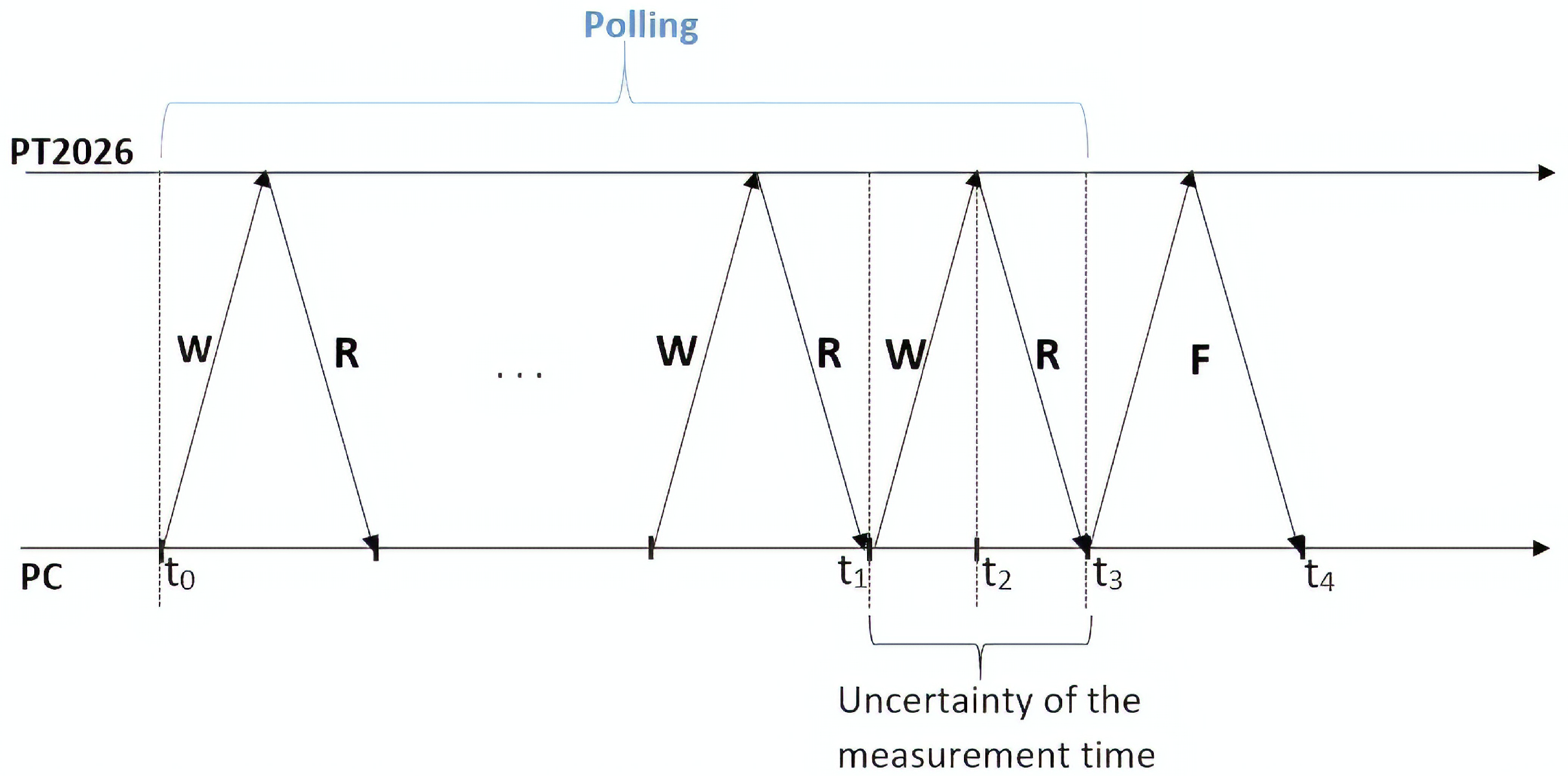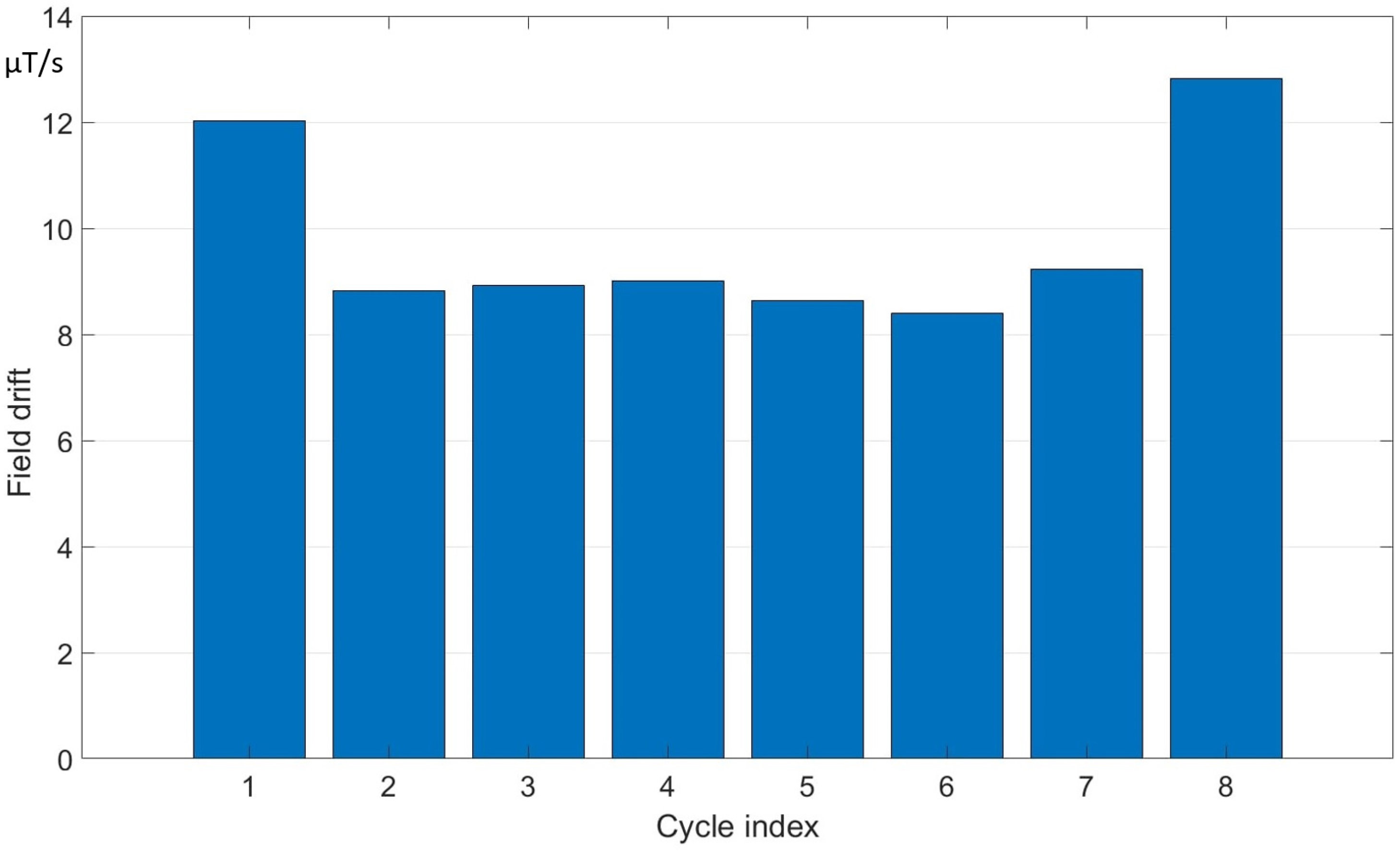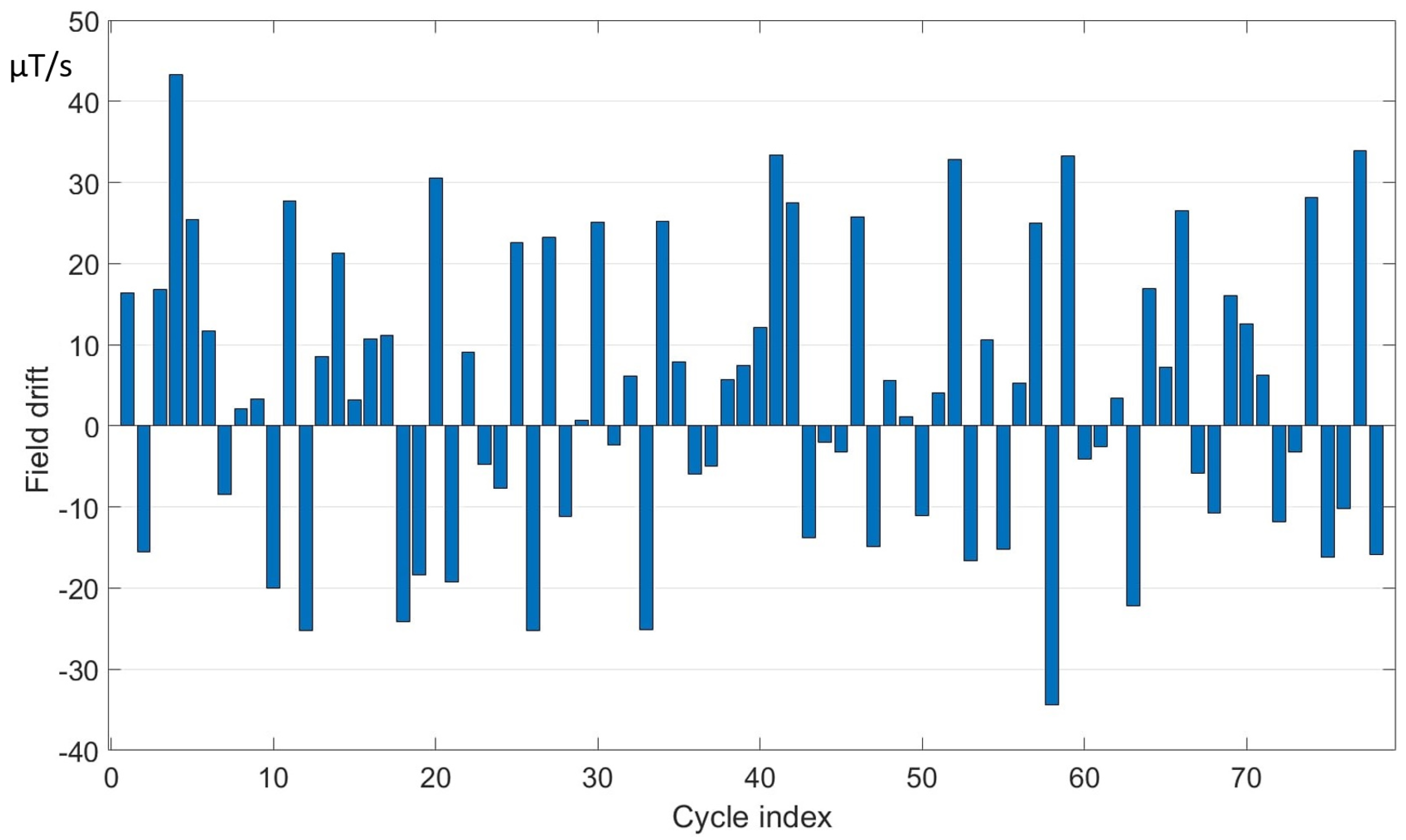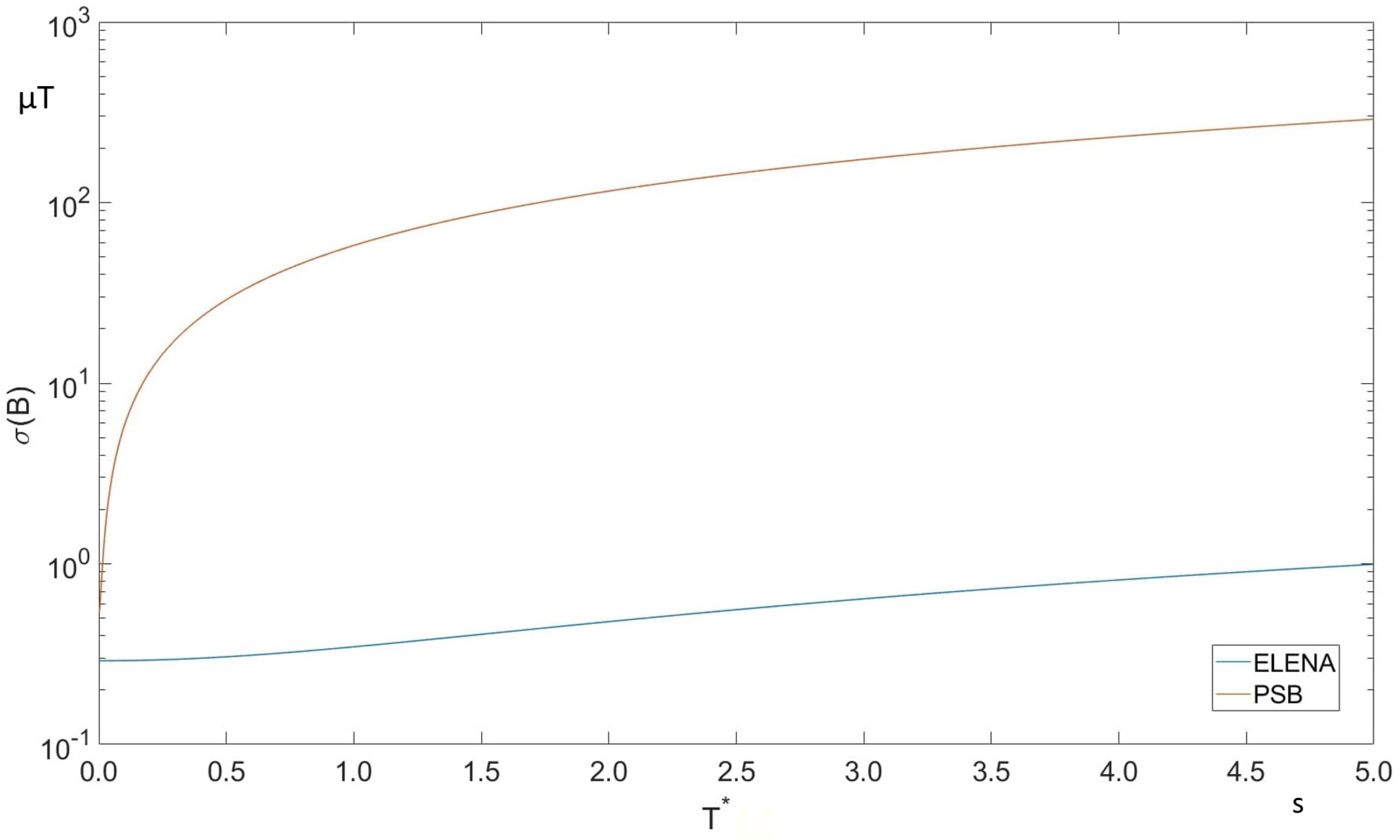Integrator Drift Compensation of Magnetic Flux Transducers by Feed-Forward Correction †
Abstract
1. Introduction
2. State-Of-The-Art Drift Correction for Fixed Induction Coils in Accelerator Magnets
3. Proposed Modelling and Correction of Integrator Drift
- replacing the preset integration constant in Equation (1) by a field measurement
- using two consecutive field marker measurements to estimate the voltage offset, which is henceforth subtracted from the voltage signal
3.1. Analytical Model
3.2. Voltage Offset Model
3.3. Feed-Forward Offset Correction
3.4. Uncertainty Analysis of Voltage Offset
- the coil surface area. This contribution arises mainly from the uncertainty of the coil calibration process and is usually very low, i.e., a few [21] in relative terms. This represents a systematic error that affects equally all measurements obtained from the coil, although not those obtained from the NMR field marker. Additional random fluctuations due to thermal effects can be neglected, since laboratory systems are usually stabilized in temperature;
- the measured field difference Equation (10); this includes two contributions, (i) from the NMR measurements, in the range of a few in relative terms and therefore negligible, and (ii) from the flux integration, dominated by the uncertainty of the coil surface and therefore also small (see Appendix A);
- the measured duration of the integration interval. Relative error can be in the percent range, as shown experimentally in Section 4.1.
3.5. Uncertainty Analysis of the Measured Field
4. Case Study on ELENA and PSB at CERN
- for the uncertainty on time measurement, in Section 4.1, the test setup with the experimental results are presented;
- the mean offset and the observed fluctuations of the offset are estimated in Section 4.2, by means of experimental data of field drift in ELENA and PSB;
- for the correction results, in Section 4.3 the experimental data discussed in the two previous subsections is used in Equation (23) to calculate the correction interval with the target uncertainty of 1 T.
4.1. Uncertainty on Time Measurement
4.1.1. Test Setup
- request the instrument to make the measurement;
- wait for the task end (polling);
- read the result.
4.1.2. Experimental Results
- the mean field value is compatible with the nominal field of the magnet (Table 1).
4.2. Mean Offset and Observed Fluctuations of the Offset
4.3. Correction Results
5. Conclusions
Author Contributions
Funding
Acknowledgments
Conflicts of Interest
Appendix A. Uncertainty of Fluxmetric Field Measurement
References
- Milotti, E. 1/f noise: A pedagogical review. arXiv 2002, arXiv:physics/0204033. [Google Scholar]
- Liu, D.M.; Zhao, W.Z.; He, Y.G.; Chen, B.; Wan, B.N.; Shen, B.; Huang, J.; Liu, H.Q. Development of an alternating integrator for magnetic measurements for experimental advanced superconducting tokamak. Rev. Sci. Instrum. 2014, 85, 11E826. [Google Scholar] [CrossRef] [PubMed]
- Rebut, P.H.; Chuyanov, V.; Huguet, M.; Parker, R.R.; Shimomura, Y. The ITER EDA outline design. In Proceedings of the Fifteenth International Conference on Plasma Physics and Controlled Nuclear Fusion Research, Seville, Spain, 26 September–1 October 1994; Volume 2. [Google Scholar]
- Bak, J.G.; Lee, S.G.; DeRac, S.; the KSTAR Project Team. Performance of the magnetic sensor and the integrator for the KSTAR magnetic diagnostics. Rev. Sci. Instrum. 2004, 75, 4305–4307. [Google Scholar] [CrossRef]
- Seo, S.; Werner, A.; Marquardt, M. Development of a digital integrator for the KSTAR device. Rev. Sci. Instrum. 2010, 81, 123507. [Google Scholar] [CrossRef] [PubMed]
- Ali-Arshad, S.; de Kock, L. Long-pulse analog integration. Rev. Sci. Instrum. 1998, 64, 2679–2682. [Google Scholar] [CrossRef]
- Arpaia, P.; Buzio, M.; De Matteis, E.; Russenschuck, S. A rotating coil transducer for magnetic field mapping. J. Instrum. 2015, 10, P06006. [Google Scholar] [CrossRef][Green Version]
- Maury, S.; Oelert, W.; Bartmann, W.; Belochitskii, P.; Breuker, H.; Butin, F.; Carli, C.; Eriksson, T.; Pasinelli, S.; Tranquille, G. ELENA: The extra low energy anti-proton facility at CERN. In Proceedings of the 11th International Conference on Low Energy Antiproton Physics, Uppsala, Sweden, 10–15 June 2013; pp. 105–115. [Google Scholar]
- Hanke, K. Past and present operation of the CERN PS BOOSTER. Int. Mod. Phys. A 2013, 28, 1330019. [Google Scholar] [CrossRef]
- Baird, S. Accelerators for Pedestrians; AB Department; CERN: Geneva, Switzerland, 2007. [Google Scholar]
- Pullia, M. Status Report on the Centro Nazionale di Adroterapia Oncologica (CNAO). IEEE Trans. Appl. Supercond. 2006, 16, 1708–1711. [Google Scholar] [CrossRef]
- Pezzetta, M.; Bazzano, G.; Bressi, E.; Falbo, L.; Pullia, M.; Priano, C.; Venchi, G.; Coiro, O.; Franzini, G.; Pellegrini, D.; et al. B-Train performances at CNAO. In Proceedings of the 2nd International Particle Accelerator Conference (IPAC’11), San Sebastián, Spain, 4 September 2011; paper MOPO039. pp. 568–570. [Google Scholar]
- Di Castro, M.; Sernelius, D.; Bottura, L.; Deniau, L.; Sammut, N.; Sanfilippo, S.; Venturini Delsolaro, W. Parametric field modeling for the LHC main magnets in operating conditions. In Proceedings of the PAC07, Albuquerque, NM, USA, 25 June 2007. [Google Scholar]
- Burnet, J.P. Putting it into practice. In Proceedings of the CAS—CERN Accelerator School: Power Converters, Baden, Switzerland, 7 May 2014; p. 445. [Google Scholar]
- Niederländer, B.; Blümler, P. Simple eddy current compensation by additional gradient pulses. Magn. Reson. 2018, 47A, e21469. [Google Scholar] [CrossRef]
- Buzio, M.; Beaumont, A.; Galbraith, P.; Golluccio, G.; Giloteaux, D.; Gilardoni, S.; Petrone, C.; Walckiers, L. Development of Upgraded Magnetic Instrumentation for CERN Real-Time Reference Field Measurement Systems; CERN-ATS-2010-142; CERN: Geneva, Switzerland, 2010. [Google Scholar]
- Metrolab NMR Precision Teslameter PT2026—User’s Manual; Version 2.1; Metrolab: Geneva, Switzerland, 2017.
- Grech, C.; Avramidou, R.; Beaumont, A.; Buzio, M.; Sammut, N.; Tinembart, J. Metrological Characterization of Nuclear Magnetic Resonance Markers for Real-Time Field Control of the CERN ELENA Ring Dipoles. IEEE Sens. J. 2018, 18, 5826–5833. [Google Scholar] [CrossRef]
- Feldmeier, E.; Haberer, T.; Galonska, M.; Cee, R.; Scheloske, S.; Peters, A. The First Magnetic Field Control (B-Train) to Optimize the Duty Cycle of a Synchrotron in Clinical Operation. In Proceedings of the IPAC2012, New Orleans, LA, USA, 2 May 2012. [Google Scholar]
- Amodeo, M.; Arpaia, P.; Buzio, M. A technique for the correction of long-term magnetic flux integrator drift. In Proceedings of the 2019 IEEE International Workshop on Metrology for Industry 4.0 and IoT, Naples, Italy, 4–6 June 2019. [Google Scholar]
- Buzio, M. Coil Calibration; CAS Bruges; CERN: Geneva, Switzerland, 2009. [Google Scholar]






| Parameter | Value |
|---|---|
| Magnet type | Metrolab PM-1055050N |
| Magnet field | 0.290 T @ 24 C |
| Magnet temperature coefficient | −1200 ppm/C |
| Probe Model | 1226 |
| Probe Range | 0.19–0.52 T |
| Teslameter Model | Metrolab PT2026 |
| Teslameter S/N | 00037 |
| Teslameter accuracy | ±5 ppm, independent of temperature |
| Teslameter measurement rate | up to 33 Hz |
| Parameter | Value |
|---|---|
| mT | |
| Mean | 290.780 |
| Standard Deviation | 0.002 |
| Min | 290.751 |
| Max | 290.805 |
| Parameter | Measurement Time | Readout Delay | Total Time |
|---|---|---|---|
| ms | ms | ms | |
| Mean | 38.5 | 5.9 | 44.3 |
| RMS | 42.1 | 7.2 | 47.5 |
| Standard Deviation | 17.2 | 4.3 | 17.0 |
| Machine | |||||||
|---|---|---|---|---|---|---|---|
| m | V | V | V/s | V | T/s | T/s | |
| ELENA | 2.8 | 27.3 | 4.7 | 0.2 | 27.7 | 9.7 | 1.7 |
| PSB | 2.4 | 9.3 | 42.5 | 57.9 | 43.5 | 3.9 | 17.7 |
| Machine | Acceptable T | |||
|---|---|---|---|---|
| s | T/s | T | s | |
| ELENA | 120 | 9.9 | 1185.5 | |
| PSB | 1.2 | 18.1 | 21.7 |
© 2019 by the authors. Licensee MDPI, Basel, Switzerland. This article is an open access article distributed under the terms and conditions of the Creative Commons Attribution (CC BY) license (http://creativecommons.org/licenses/by/4.0/).
Share and Cite
Amodeo, M.; Arpaia, P.; Buzio, M. Integrator Drift Compensation of Magnetic Flux Transducers by Feed-Forward Correction. Sensors 2019, 19, 5455. https://doi.org/10.3390/s19245455
Amodeo M, Arpaia P, Buzio M. Integrator Drift Compensation of Magnetic Flux Transducers by Feed-Forward Correction. Sensors. 2019; 19(24):5455. https://doi.org/10.3390/s19245455
Chicago/Turabian StyleAmodeo, Maria, Pasquale Arpaia, and Marco Buzio. 2019. "Integrator Drift Compensation of Magnetic Flux Transducers by Feed-Forward Correction" Sensors 19, no. 24: 5455. https://doi.org/10.3390/s19245455
APA StyleAmodeo, M., Arpaia, P., & Buzio, M. (2019). Integrator Drift Compensation of Magnetic Flux Transducers by Feed-Forward Correction. Sensors, 19(24), 5455. https://doi.org/10.3390/s19245455







